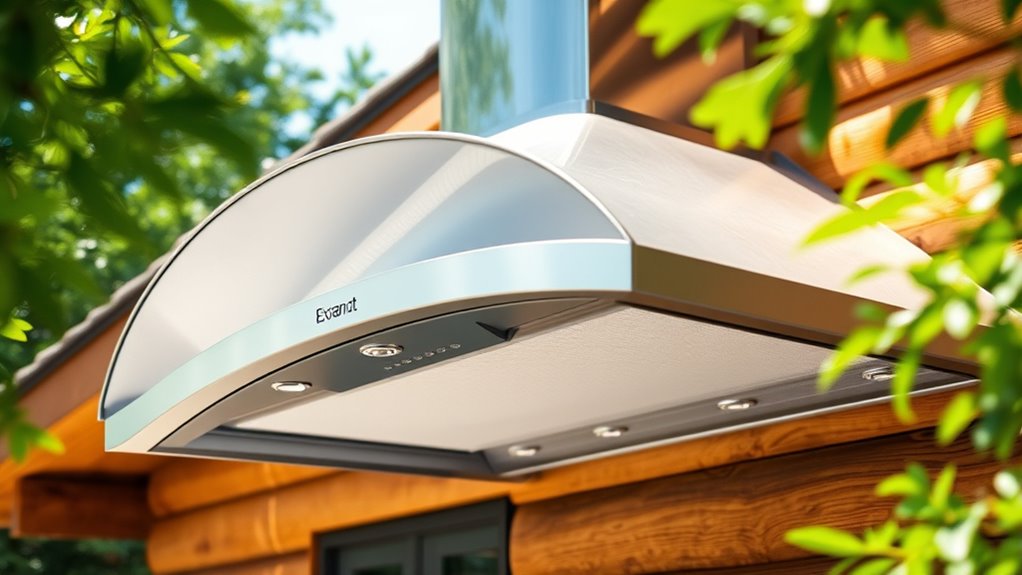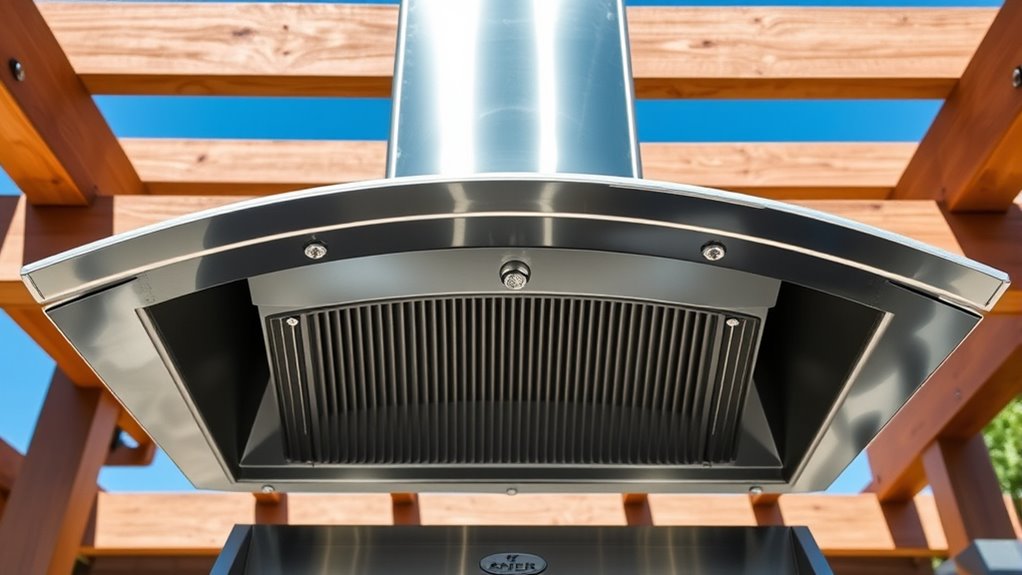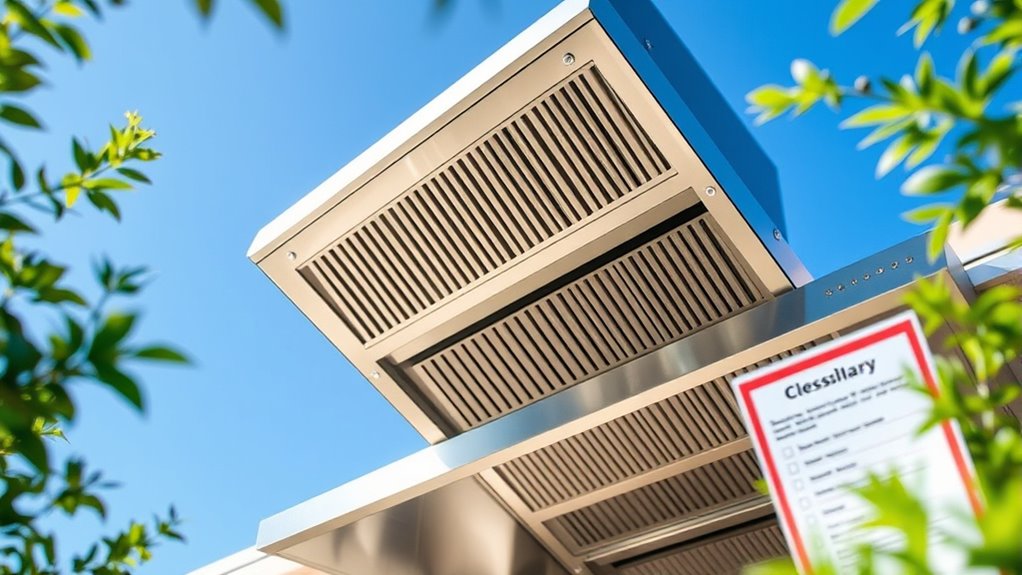Before you start installing an outdoor vent hood, it’s important to understand key terms like airflow rate (CFM), weather resistance, and components like blowers, filters, and ductwork. Knowing safety tips, such as proper mounting and sealing, helps prevent hazards and guarantees durability. Make sure to choose weather-resistant materials like stainless steel and verify all components meet ventilation standards. Continue exploring these essentials to set yourself up for a safe and effective outdoor ventilation setup.
Key Takeaways
- Understand essential outdoor vent hood components such as blowers, filters, ductwork, and controls for effective installation.
- Familiarize yourself with safety standards and weather resistance requirements to ensure durability and compliance.
- Assess airflow needs (CFM ratings) to match the vent hood’s capacity with your outdoor cooking space.
- Verify the stability of mounting brackets and proper sealing of ductwork to prevent leaks and ensure safety.
- Consider materials like stainless steel for weather resistance and review installation checklists before starting.
Essential Terminology for Outdoor Vent Hoods

Understanding key terms is essential when selecting or installing outdoor vent hoods. Familiarize yourself with ventilation standards, which set the safety and performance benchmarks for outdoor exhaust systems. These standards ensure your vent hood effectively removes fumes, smoke, and odors, maintaining a safe environment. Recognizing terms like airflow rate, measured in cubic feet per minute (CFM), helps you choose a hood capable of handling your specific exhaust needs. It’s also important to understand how weather resistance impacts outdoor exhaust, as your vent hood must withstand the elements while functioning efficiently. By grasping these basic terms, you’ll be better equipped to evaluate options, ensure compliance, and select a vent hood that provides reliable, safe outdoor exhaust performance. Additionally, understanding interior considerations can help you coordinate your outdoor vent system with your overall space for a cohesive look.
Key Components and Features to Know

When selecting an outdoor vent hood, it’s crucial to familiarize yourself with its key components and features that guarantee peak performance and durability. The blower or fan is essential for effective outdoor kitchen ventilation, removing smoke and odors efficiently. The filters trap grease and debris, making vent hood maintenance easier and prolonging the unit’s lifespan. The ductwork directs airflow outside, so ensure it’s properly sealed to prevent leaks. Controls, such as switches or digital panels, allow you to operate the system smoothly. Materials like stainless steel resist weather damage and corrosion. Features like adjustable speed settings and built-in lighting enhance functionality. Understanding these components helps you choose the right vent hood, ensuring long-term performance and making outdoor cooking more enjoyable and safe. Additionally, considering essential oils for outdoor environments can improve the overall ambiance and air quality around your outdoor kitchen.
Safety Tips and Checklist for Installation

Installing an outdoor vent hood safely is essential to prevent accidents and guarantee peak performance. A proper installation ensures fire safety and long-lasting operation. Use an installation checklist to stay organized and avoid missing critical steps. Additionally, verifying the stability of the mounting brackets is crucial, as loose brackets can lead to the hood falling and causing damage or injury.
Frequently Asked Questions
How Do I Choose the Right Vent Hood Size for My Outdoor Kitchen?
To choose the right vent hood size for your outdoor kitchen, consider the vent hood dimensions that match your cooking area. You want it to extend beyond your grill or stove to effectively capture smoke and fumes. For ideal outdoor kitchen ventilation, measure your cooking zone carefully, then select a vent hood that’s at least as wide as your cooking surface. Proper sizing ensures efficient airflow and keeps your outdoor space comfortable.
What Materials Are Best for Outdoor Vent Hoods in Various Climates?
For outdoor vent hoods, choose materials like stainless steel or aluminum, as they offer excellent durability against weather elements. In humid or coastal climates, stainless steel resists corrosion best, while powder-coated metals work well in dry, sunny areas. Consider climate adaptation by selecting materials that withstand rust, fading, and temperature fluctuations, ensuring your vent hood remains functional and attractive over time. Durability and climate-specific features are key to long-lasting outdoor vent hoods.
How Often Should I Clean or Maintain My Outdoor Vent Hood?
Think of your outdoor vent hood as the guardian of your cooking sanctuary. You should clean it every 3 to 6 months, depending on usage, to keep it performing at its best. Regular maintenance tips include inspecting for grease buildup, checking filters, and ensuring proper airflow. By doing so, you protect your investment and keep your outdoor space safe and inviting. Consistent care preserves the heart of your outdoor kitchen.
Can I Install a Vent Hood Myself or Should I Hire a Professional?
You can attempt a DIY installation of your outdoor vent hood if you have basic handyman skills and follow the manufacturer’s instructions carefully. However, for maximum safety, proper venting, and compliance with local codes, it’s often best to hire professional assistance. Professionals ensure your vent hood is installed correctly, reducing risks of leaks or fire hazards, and saving you time and potential future costs.
What Are Common Troubleshooting Issues With Outdoor Vent Hoods?
Lost in the digital age, you might forget that outdoor vent hoods face common issues like clogged vent hood filters and outdoor vent blockages. These problems reduce airflow and cause smoke or odors to linger. Regularly clean or replace filters and inspect for debris or nests blocking the vent. If airflow remains weak, check for obstructions outside, clear them, and make sure the vent cap is functioning properly for maximum performance.
Conclusion
Think of your outdoor vent hood as the captain of a ship, guiding smoky seas safely away from your home. With the right knowledge of terminology, components, and safety checks, you’re steering clear of storms and leaks. When you understand these basics, you’re not just installing a vent hood—you’re charting a course toward a safer, more efficient outdoor space. Set sail confidently, knowing you’ve got the essentials to keep your home protected and thriving.









